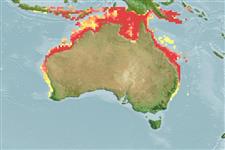>
Scombriformes (Mackerels) >
Scombridae (Mackerels, tunas, bonitos) > Scombrinae
Etymology: Scomberomorus: Latin, scomber = mackerel + Greek, moros = silly, stupid (Ref. 45335).
Environment: milieu / climate zone / depth range / distribution range
экология
морской; солоноватоводный; мигрирует в океане (Ref. 51243); пределы глубины 1 - 100 m (Ref. 6390), usually ? - 30 m (Ref. 6390). Tropical; 7°S - 35°S, 110°E - 157°E (Ref. 168)
Western Pacific: largely confined to inshore coastal waters of southern Papua New Guinea and northern and eastern Australia, from Shark Bay and Onslow, Western Australia to Sydney, New South Wales. This species was confused with Scomberomorus guttatus.
Length at first maturity / Size / Вес / Возраст
Maturity: Lm ?, range 48 - ? cm
Max length : 100.0 cm FL самец/пол неопределен; (Ref. 168); common length : 80.0 cm FL самец/пол неопределен; (Ref. 168); наибольший вес (опубликованные данные): 12.2 kg (Ref. 3132)
колючие лучи спинного плавника (общее число): 16 - 18; членистые (мягкие) лучи спинного плавника (общее число): 17-19; колючие лучи анального плавника 0; членистые (мягкие) лучи анального плавника: 16 - 20; позвонки: 48 - 49. Interpelvic process small and bifid. Lateral line gradually curving down toward caudal peduncle. Intestine with 2 folds and 3 limbs. Swim bladder absent. Body covered with small scales. Membrane of first dorsal fin jet black with large contrasting areas of intense white between the 6th and the last spine. Sides of adults marked with about three indefinite rows of indistinct bronze-gray blotches (absent in 9.5 cm juveniles).
Schooling species which moves into inshore waters, bays and estuaries of Queensland during the southern midwinter and early spring. Often inhabit very turbid coastal waters shallower than 30 m (Ref. 6390). Common length 50 to 80 cm FL (Ref. 12241). Seasonally migratory in the Gulf of Carpentaria and form mixed schools with S. commerson over shallow reefs offshore of Queensland. Trolling lines with lures such as metal spoons and cut bait are used by recreational and commercial fishermen. Mostly marketed fresh (Ref. 9987).
Life cycle and mating behavior
половая зрелость | размножение | нерест | икра | Fecundity | личинки
Collette, B.B. and C.E. Nauen, 1983. FAO Species Catalogue. Vol. 2. Scombrids of the world. An annotated and illustrated catalogue of tunas, mackerels, bonitos and related species known to date. Rome: FAO. FAO Fish. Synop. 125(2):137 p. (Ref. 168)
Статус Красного Списка МСОП (Ref. 130435)
Угроза для людей
Reports of ciguatera poisoning (Ref. 6390)
Использование человеком
рыболовство: коммерческий; объект спортивного рыболовства: да
дополнительная информация
ссылкиаквакультура (рыбоводство)особенности рыбоводствастепень растяжениягенетикаElectrophoresesнаследуемостьболезниобработкаNutrientsMass conversion
соавторыизображенияStamps, Coins Misc.звукиCiguateraскоростьтип плаванияжаберная областьOtolithsмозгзрение
инструменты
Специальные отчеты
Скачать в формате XML
ресурсы в Интернет
Estimates based on models
Preferred temperature (Ref.
123201): 24.5 - 28.6, mean 27.4 °C (based on 302 cells).
Phylogenetic diversity index (Ref.
82804): PD
50 = 0.5000 [Uniqueness, from 0.5 = low to 2.0 = high].
Bayesian length-weight: a=0.00832 (0.00383 - 0.01808), b=3.03 (2.86 - 3.20), in cm total length, based on LWR estimates for this Genus-body shape (Ref.
93245).
Trophic level (Ref.
69278): 4.5 ±0.8 se; based on diet studies.
устойчивость к внешним воздействиям (Ref.
120179): средний (среднего размера), минимальное время удвоения популяции 1.4-4.4 года (tm=1-2).
Fishing Vulnerability (Ref.
59153): Low to moderate vulnerability (33 of 100).
Nutrients (Ref.
124155): Calcium = 38.2 [17.5, 147.4] mg/100g; Iron = 0.94 [0.43, 2.31] mg/100g; Protein = 21 [20, 22] %; Omega3 = 0.295 [0.178, 0.499] g/100g; Selenium = 66.7 [23.7, 308.3] μg/100g; VitaminA = 14.9 [2.9, 71.4] μg/100g; Zinc = 0.756 [0.504, 1.192] mg/100g (wet weight);
